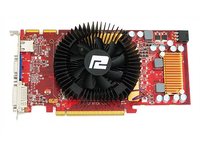Radeon HD 4830: High-Speed, Cheap CrossFire
PowerColor's Radeon HD 4830
PowerColor’s 4830 offering comes in an attractive package with very few extras. It's comprised of the card, a driver CD, and a manual. But before you complain about the lack of adapters for different output types, have a closer look at the card itself:
We don’t really need adapters, as the card comes with a DVI output, an HDMI output, and an analog VGA output. On one hand, we do have to say it’s a pleasant rarity to find a card that doesn’t require irritating adapters to work on a variety of outputs, but on the other hand, it’s just as irritating that we’d have to buy an HDMI-to-DVI adapter if we wanted to run two DVI monitors. As well, there is no S-video or component output for TV connections. Still, the PowerColor card gets some points for the adapter-less approach.
Our only real complaint is the lack of a CrossFire cable with the card. If you buy another PowerColor Radeon HD 4830, you still won’t be able to put them in CrossFire mode without that cable. They can be purchased separately, but the cable should really be standard issue.
PowerColor’s 4830 sticks close to the reference AMD 4830 board, but with some important differences--most notably the large dual-slot GPU cooler. While this cooler isn’t designed to throw heated air out of the case, its size does suggest that it will do a good job cooling off the RV770LE graphics processor.
The video memory chips are covered by two heat spreaders. As some of the memory is located below the fan heat sinks (but a few are located a little outside of the fan profile) , these spreaders are an interesting choice to keep memory temperatures equal and perhaps add a bit of surface area. Unfortunately, the spreaders are glued on, which is not our favorite method of fastening something this size, but they seems to do the job.


Under those heat spreaders is Qimonda's HYB18H512321BF-10 GDDR3 memory, which is rated for 1, 000 MHz. At 900 MHz, this memory is a little under-clocked, so we have some hope that it would tune a bit higher. In fact, this exact type of memory has seen use on Radeon HD 4850 cards that run 993 MHz stock.
Speaking of clock speeds, PowerColor’s card runs at the reference 575 MHz core and 900 MHz memory speeds when in 3D mode. In 2D mode, the card will perform a little more efficiently by lowering the clock speeds to 453 MHz core and 750 MHz memory.
Get Tom's Hardware's best news and in-depth reviews, straight to your inbox.
Current page: PowerColor's Radeon HD 4830
Prev Page A Closer Look At The Radeon 4830 Next Page Sapphire's Radeon HD 4830Don Woligroski was a former senior hardware editor for Tom's Hardware. He has covered a wide range of PC hardware topics, including CPUs, GPUs, system building, and emerging technologies.
-
Doltron If you couldn't get Tray Tools to work with the Sapphire card why not use another program? Instead of giving up and coming up with a lame conclusion.Reply
Also 993*2 doesn't equal 1885 and the 4870 is clocked at 750 not 780.
Your sound and temp charts have FPS on their X axis. -
hannibal It's nice to see good cards from both companies, ATI and NVidia!Reply
And the price is not bad at all. The competition is so good!
-
neiroatopelcc The chart on page two sais 4850 runs at 625 - but stock is 600, and 4870 at 780 - which is 750 stock ... so is the 4830 speed correct?Reply -
V3NOM I'm sure i saw that "4850 - smarter by design" article at anandtech first. or somewhere else... the name anyway not necessarily the article >.>Reply -
giovanni86 I knew that the 8800GT wasn't that fast, but those benchmarks ahve to be wrong... Sorry Nvidia fan boy here. Bye.Reply -
V3NOM Um actually, the MSI runs at x16/x8 in SLI mode. If you instead got an evga 750i FTW motherboard, you would find it runs at x16/x16 in sli, thanks to its unlocked NF200 chip. the 750i FTW is not a reference nvidia board as the MSI is.Reply

